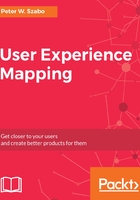
The audience
You should focus on the audience. What are their problems? What would make them listen actively, instead of texting or catching Pokémon, while at a user story discussion? Even if the project is about scratching your own itch, you should spin the story so it's their itch that is scratched. Engaging the audience can be indeed a challenge.
The book seemed to be a success. A national TV channel did an interview with me, and I certainly got to all local newspapers, as a young author. Even more importantly, I had lots of fun writing it. However, the book itself was hard to understand and probably impossible to appreciate. My biggest mistake was writing only what I considered fun. To be honest, I still write for fun, but now I have an audience in mind. I tell the story of my passion for user experience mapping to a great audience: you. I try to find things that are fun to write and still interesting to my target audience. As a true UX geek, I create the main persona of my audience before writing anything and tell a story to them. We will get to personas in the next chapter. For this book, I call the main persona Maya, and she shares many traits with my daughter. Could I say, I'm writing this book for my daughter? Of course, I do, but I also keep in mind all other personas. Hopefully, one of them is a bit like you.
Before a talk at a conference, I always ask the organizers about the audience. Even if the topic stays the same, the audience completely changes the story and the way I present it. I might tell the same user story differently to one of my team members, to the leader of another team, or to a chief executive. Differently internally, to a client or a third party.
When telling a story, contrary to a written story, you will experience an immediate feedback or the lack of it from your audience. You should go even further and shape the story based on this feedback.
When you tell a fairy tale to your daughter, she might ask you, why can't the princess escape using her sharp wits and cunning, instead of relying on a prince challenging the dragon to a bloody duel? Then, you might start appreciating the story of My Little Pony, where the girl ponies solve challenges mostly nonviolently while working together as a team of friends, instead of acting as a prize to be won. So, why not spin a tale of heroic princesses with fluffy pink cats?